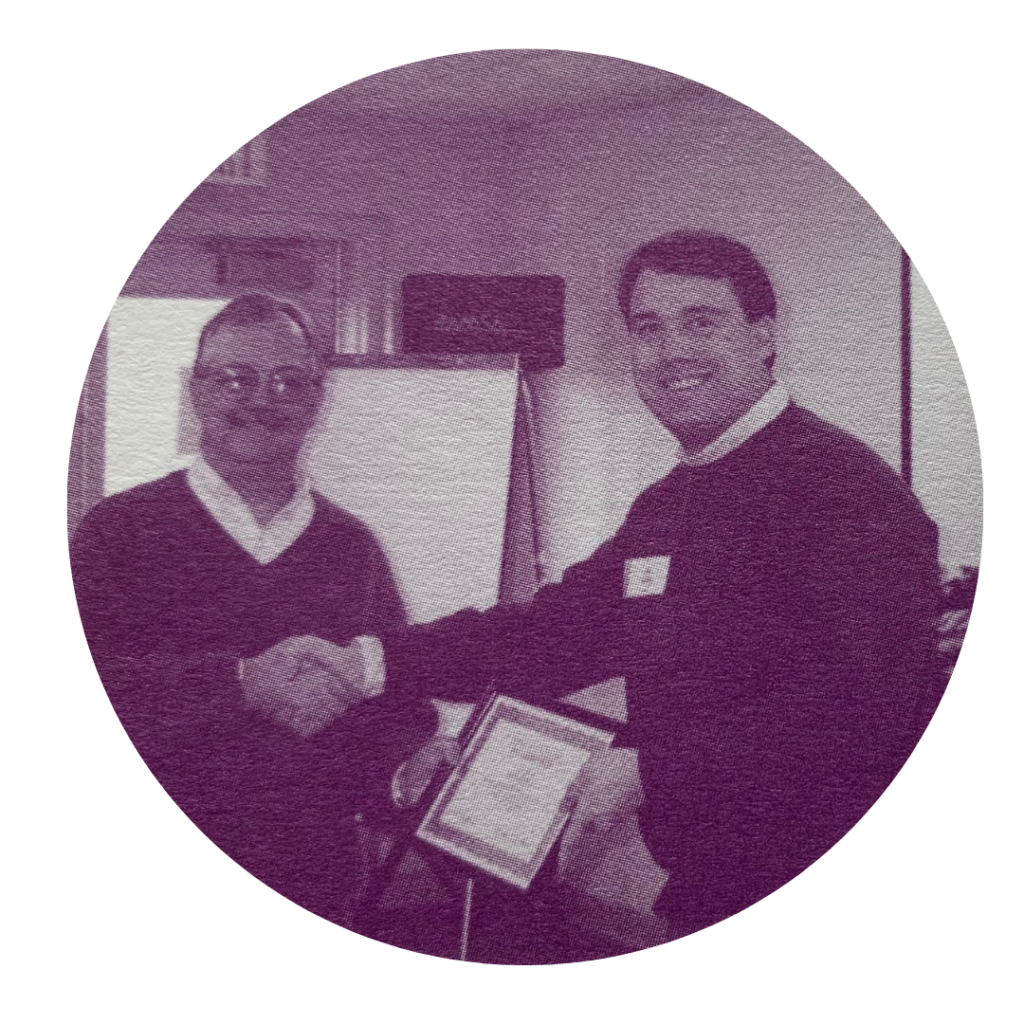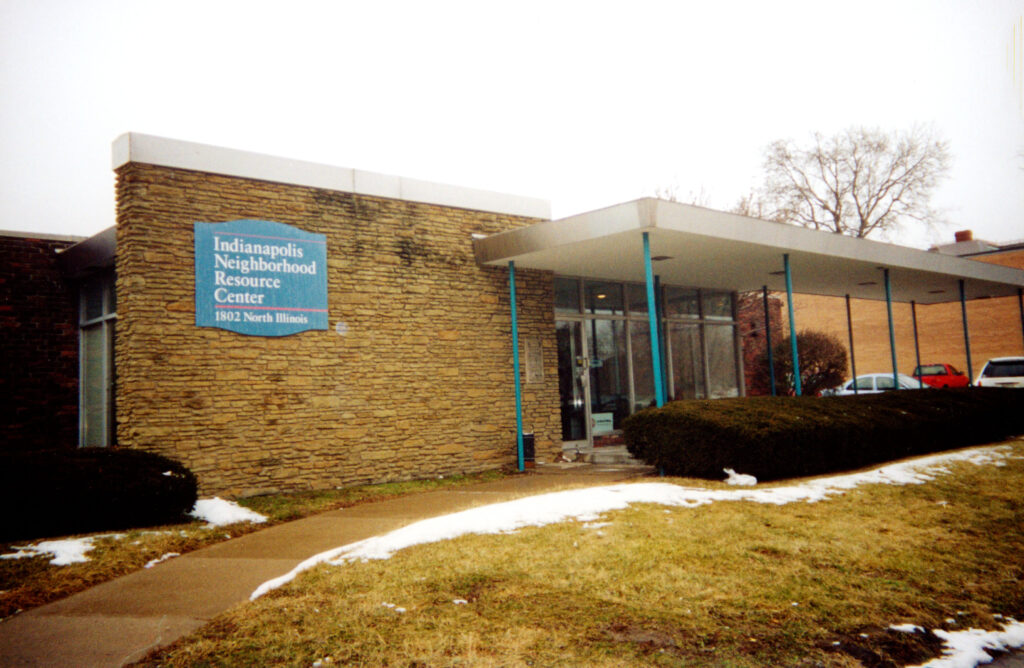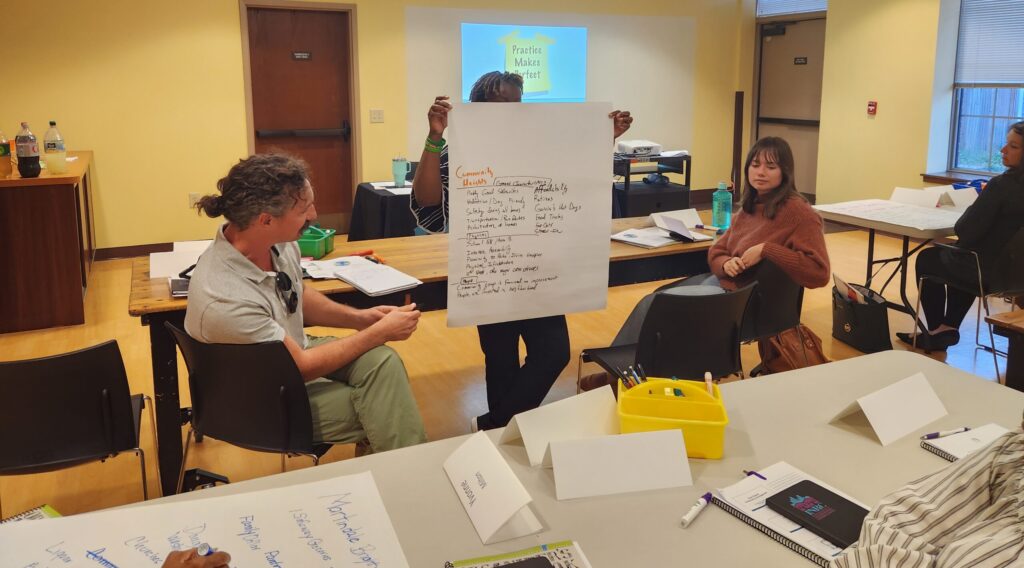June 17, 2024
Celebrating 30 Years of INRC: A Conversation with Former Executive Director Monty Hulse
By Danae Freeman, Engagement Manager

Monty Hulse (Left), Indianapolis Neighborhood Leadership Academy Graduate (Right) 2000
Monty Hulse is a historian, entrepreneur, writer, and community builder local to Indianapolis. His career spans back to the 1970s and he has worked in senior positions at organizations and institutions such as Conner Praire, IUPUI, Early Learning Indiana, and The Indiana Afterschool Network. More recently, Monty has led his own freelance business facilitating training related to realistic and organized strategies to build strong, connected communities called “The Community Workshop”.
We sat down with Monty, INRC’s 4th Executive Director from 2000-2004 to reflect on the organization’s history, evolving work with neighborhoods, and what it means to be involved in supporting the growth of Indianapolis communities.
“Well, just for context. I have a graduate degree in history. Worked at Conner Prairie and other museums prior to going into this line of work. And so, I appreciate what you’re doing.”
On His Role as Former Executive Director
Monty was hired as Executive Director while the organization was going through several transitions. At the time, the staff was comprised of himself and one other individual.
He led the path for INRC to receive a former agency designation from United Way of Indiana which allowed for the organization to leverage more capacity and resources for the development of programming dedicated to what neighbors and partners cared about
A large project for Monty was expanding and regularizing INRC’s training program which was the beginning of INRC’s current Indianapolis Community Building Institute called the Indianapolis Neighborhood Leadership Academy.
He led training courses that occurred every year, sometimes multiple times a year, that were of widespread interest such as starting a neighborhood-based business, board development, grant writing, and others. Monty magnified and developed these free offerings and attendee participation.
He also supported a former INRC event called Neighbor Fest which was the predecessor to Neighbor Power Indy, our event bringing together neighbors from across the city to celebrate community accomplishments.
“We had entertainment from the community, and we had food vendors from around the community. We generally had a resource fair, so different kinds of groups would come in and share resources and it was an opportunity to celebrate. We did that at the West 18th and Illinois site (the location of INRC’s old building) at least once I remember.
I mean Neighbor Power Indy is a different kind of event in terms of that it offers opportunities for neighbors to lift themselves up and tell their own stories and that is different than what we did and really good.”

INRC’s building until 2014
Monty also discussed how in his role, he wanted to take action to provide additional outreach and assistance to neighborhoods to realistically serve their situations.
“We started talking about kind of a tripod of programmatic initiatives. Training, but also technical assistance, and community building. And so around technical assistance, we would frequently get a call from somebody in a neighborhood that was having some sort of issue. Frequently it was a challenge that was coming up. And so, we were able to use some resources to either have staff from INRC go out and provide kind of problem-solving and work with them as essentially a consultant to try to solve those problems and to find other resources to try to work through some issues.”

Technical Assitance Trainings 2000
Monty shared that sometimes the neighborhood problems were difficult to navigate and deep-rooted. He shared that one of the most memorable situations was when a CDC filed for bankruptcy, and they had acquired several properties they were maintaining with the initial goal of redevelopment. As a result of the complex changes, a group of organizations that included INRC banded together as a task force over several months, and eventually a new CDC was created and established.
“We first tried to process through the grief and the anger that that organization had closed, and then determine what the next steps would be. So, we worked with the community to develop and think through, what are we going to do? They came up with a very grassroots-oriented approach, where neighbors were helping neighbors.”
Monty shared that it was a process of problem-solving alongside them while also utilizing community organizing strategies at a time when “community organizing” as an idea was not widely supported.
“The power structures in the funding community were concerned with the challenges that would face. Certainly, that’s a challenge to their comfort in their power and the status quo. The racial and class issues that become part of it. Also, historically community organizing, say in the 1930s-1970s, had a much more confrontational approach to it. Now certainly, Asset-Based Community Development is around building strengths and not around just confronting power. It doesn’t ignore the need for confronting power, but it also looks at other ways to do that. So, I think that people see the value of just trying to build on strengths. Even if they are still fearful of being confronted with inequities.”

Neighbors participating in Asset-Based Community Development Training during Indianapolis Community Building Institute 2023
He reflected on INRC’s start with sharing the Asset Based Community Development philosophy (ABCD). ABCD guides community members on how to recognize assets in their neighborhoods to use what they have to develop their community and make positive change.
Staff began making connections with the Asset-Based Community Development Institute and from those collaborations and conversations, INRC’s Asset-Based Community Development training was created.
Leaders from the Institute and INRC staff began brainstorming on how to apply the curriculum to what Indianapolis neighbors cared about and were working on in their communities.
“We were coming in doing training and working with small groups of residents around the city around learning Asset Based Community Development and applying it in the neighborhood. There was already a lot of interest in the community, and it was an environment where folks were very interested in learning about it and starting to use it. So that became a framework and a model of how community building would look in Indianapolis.
Then one of the ways we were able to apply that framework was by working with the Annie E. Casey Foundation (AECF), which is a national foundation out of Baltimore, that was doing a national initiative called “Making Connections” which is a comprehensive community initiative related to how do you really bring positive change to neighborhoods that are challenged. They emphasize that at the heart of it, you had to have the residents in the neighborhood the neighbors need to be leading that effort. And so, making connections with those values in place and wanting to work towards the goal that we want our children to succeed, and we know that for children to succeed, they need to have strong families and supportive communities. So, it introduced the idea of two generations of working with families and kids and the comprehensive work to build up the whole community.”
The work with the (AECF) focused on a couple of neighborhoods in the early 2000s in the Martindale Brightwood and Fountain Square communities. They focused on activities related to intensive technical assistance training and supporting organizing work.
They wanted to expand that to look at broader issues to take the idea of comprehensive community development to empower residents that they could do more in their neighborhoods and have a vision that they could work towards realizing.
Monty departed from INRC in 2004 and then went on to work on “Bridges to Success”, a Community Schools Initiative at United Way, IPS, and then to Making Connections Indianapolis.
What Monty is Doing Now in Indy
“I’m on the border by a neighborhood association, which is the Highland Kessler Civic League. Our boundaries are Kessler North Drive, Michigan Road, and the White River so between 51st Street and Kessler Avenue, and we’re pretty active. I also am still working in the Martindale Brightwood community quite a bit and the Edna Martin Christian Center, which is doing a Martindale Brightwood Education Zone that is still continuing to realize the two-generation comprehensive work with the focus on results for kids and families. And so, I am working with them and then doing some other work with some other organizations and in the city. Sometimes community organizations but others as well.”
What Brought Him to INRC
Monty mentioned that his interest originated from being a historian in graduate school in Delaware. He had worked on a part-time project sharing the history of a Neighborhood Center in Wilmington, Delaware which became a history exhibit and a book.
He researched the idea of community studies around rural communities which then branched into urban communities.
Monty also worked on managing a portfolio with the Encyclopedia of Indianapolis and worked on telling neighborhood stories covering broad topics as well as information about specific neighborhoods.
“We wrote an essay about the evolution of neighborhoods and where they were at that point in time, which was 1990, mid-1990s. And how that was emerging as a more important concept in the city.
“We also did a project on religion and urban culture where we were looking at the intersection of churches and faith communities in neighborhoods and in several communities and produced a series of timelines for neighborhoods.”
Monty shared a timeline he had worked on for including neighborhoods such as Mapleton Fall Creek, Martindale Brightwood, Fountain Square, the Southeast side, Crooked Creek, and the Northwest side.
“We did a whole series of those which seem to have a life of their own now because that was one of the few comprehensive works on that. So, I was doing that kind of work, and in the context of working with neighborhood folks, I just really got to enjoy that, and I wanted to be on the ground and not trying to be doing that from the university perspective. So, as I interacted with INRC, and over time when that opportunity came up, I was interested in getting more on the ground with it.”
Reaction to INRC’s 30th Anniversary
Monty expressed that he is excited, pleased, and hopeful for INRC’s future.
“I got to see that there were other kinds of similar neighborhood service organizations around the country. Frequently they were part of a city government. And that kind of organization was different than INRC, because then it became a policy enforcement, it became part of the city government. It wasn’t neighborhoods, INRC had to be led by a board of neighborhood residents. To have those direct connections to the neighborhood was, I thought, really powerful and important.
You need. I think some really bold and visionary funders in the community. You need to have a powerful community behind it. And so, I’m very pleased that INRC has been able to maintain that stance and I hope that can continue.”
Memories of INRC
Monty shared that some of his favorite memories of INRC revolve around the people he worked directly with and near. He mentioned that he had met some very important people in the history of the city noting several neighborhood leaders such as African American men and women from the 50s who had been involved with the Civil Rights Movement organizing neighborhood leaders all over the city.
“The African American leaders represented their communities during that period of key transition and really established the basis of it. They were an important part of the Civil Rights Movement in the 50s and 60s and to have known some of those folks was really meaningful to me.
Some of the events meant a lot too but I think just mostly the people. To have met historic leaders but also to see new leaders develop, and that was that was the most meaningful part.”
Have Indianapolis Neighbors’ Priorities Shifted?
Monty thoughtfully reflected on what he noticed was important to neighbors in the early 2000s compared to today.
“Housing, infrastructure, safety, health, and wellness are still all kinds of issues at the same level. Whatever progress has been made. There’s been kind of corresponding challenges that have come up with that. I think there is a greater degree of sophistication and knowledge by many neighborhood leaders and neighborhood organizations around how to reverse those issues. Leadership continues to develop even as situations have gotten more complex.
20 years ago, neighborhoods did not explicitly think about education in the same way, and I think there are a couple of reasons for that. They didn’t consider it in their purview.
Part of it is that most neighborhood associations are led by homeowners, and they’re also led by people who are older so their kids might have been beyond school age. And so, the education issues are not necessarily at the forefront of those people who were leading the neighborhood associations. That’s part of it. Another thing that was important, certainly 20 years ago, was the desegregation busing order that was made in 1970 was implemented around 1980 was still in full view, which meant that many of the neighborhoods in Center Township, in urban Indianapolis, those kids were being bused to suburban townships. So that was still in place for all the trauma that meant for the long displacement that meant for kids and families but also for communities who were there. That order was reversed and so kids are starting to come back. And so, you start to do things differently. You hadn’t had kids in your neighborhood, where you had to think about how they would be educated. That was happening at the same time that issues around charter schools and magnet schools were being introduced. So, it becomes a much more complex environment. But I think in conjunction with quality-of-life plan planning, I think neighborhoods more explicitly understand the critical importance of schools and education in their neighborhood ecosystems. And so that’s become part of their thought process around it as they’re thinking of what they need to have a good neighborhood.
Another thing that may be different is that I think there’s perhaps more direct attention to issues of racial inequities. It was coded on both sides 20 years ago, it’s still coded. But it’s I think there’s more tendency to be more direct and around the issues, not that leads to solutions or even a willingness to do solutions, but at least some people are willing and able, to be honest and direct about the identified inequities and, and trying to say there needs to be solutions. I think that most people who are doing it are probably people of color.”
Advice for Neighbors Interested in Community Organizing
“I think there’s no work that’s more important and it’s difficult and it’s just time-consuming. It’s all in the details and all the relationships. People want to have a community built but they’re too frequently not willing to go out and talk one-on-one to people. Get out of your office and go out on people’s porches at least or in the neighborhood gathering places doing that kind of work. You can say “community organizing” in Indianapolis which you couldn’t do 20 years ago. And you can talk about doing it and you can actually do it. It’s not being done enough.”





